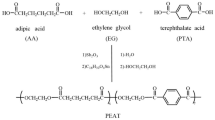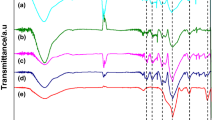Abstract
Glycidyloxypropyl-polyhedral oligomeric silsesquioxanes (G-POSS) were prepared from 3-glycidyloxypropyl-trimethoxysilane (GTMS) by hydrolytic condensation. The hybrid cationic thermal polymerization of G-POSS with bisphenol A epoxy resin (E-51) using diphenyliodonium fluoride borate (DPI·BF4) as a cationic initiator and benzoyl peroxide (BPO) as a co-initiator was investigated by DSC and FTIR. The structure of G-POSS was characterized by liquid chromatography–mass spectrometry (LC/MSD), FTIR and NMR. The effect of BPO content on reaction system, the distribution of G-POSS in the curing system, curing reaction activation energy E a and dynamic mechanical properties of the E51/G-POSS nanocomposites were characterized. The results showed that octa(3-glycidyloxypropyl)-POSS (G-POSS) had been synthesized and displayed uniform dispersion in E51/G-POSS curing system. The DPI·BF4, which was capable to initiate the thermal ring-opening curing of epoxy resin, showed an initial curing temperature of epoxy resin decreased by 54.7 °C when the added amount of BPO was 2 wt%. The reaction process was well accorded with Kissinger’s kinetics model, and the average curing reaction activation energy E a was increased as the content of G-POSS increased. The T g and storage modulus of the E-51/G-POSS nanocomposites reached its optimum when the content of G-POSS was 2 wt%. The T g of nanocomposite was 8.3 °C higher than that of the pure epoxy resin. The T g and storage modulus decreased with the further increasing of G-POSS content.










Similar content being viewed by others
References
Mohan P (2013) A critical review: the modification, properties, and applications of epoxy resins. Polym Plast Technol Eng 52:107–125
Clayton AM (1988) Epoxy resins chemistry and technology, 2nd edn. Marcel Dekker, New York
Jin H, Mangun CL, Griffin AS, Moore JS, Sottos NR, White SR (2014) Thermally stable autonomic healing in epoxy using a dual-microcapsule system. Adv Mater 26:282–287
Rakshit PB, Jain RC, Shah SR, Shrinet V (2011) Synthesis and characterization of cycloaromatic polyamines to cure epoxy resin for industrial applications. Polym Plast Technol Eng 50:647–680
Crivello JV, Lam JHW (1977) Diaryliodonium salts. A new class of photoinitiators for cationic polymerization. Macromolecules 10:1307–1315
Wang T, Wang ZH (2005) Cationic photopolymerization of epoxy systems initiated by cyclopentadien-iron-biphenyl hexafluorophosphate ([Cp-Fe-biphenyl]+PF6 −). Polym Bull 53:323–331
Abu-Abdoun II, Ledwith A (2007) Photoinitiated cationic polymerization of epoxide and vinyl monomers by p-trimethoxytrityl salts. J Polym Res 14:99–105
Oxman JD, Jacobs DW, Trom MC, Sipani V, Ficek B, Scranton AB (2005) Evaluation of initiator systems for controlled and sequentially curable free-radical/cationic hybrid photopolymerizations. J Polym Sci, Part A: Polym Chem 43:1747–1756
Sangermano M, Malucelli G, Priola A, Mannea M (2006) Synthesis and characterization of acrylate-oxetane interpenetrating polymer networks through a thermal-UV dual cure process. Prog Org Coat 55:225–230
Pappas SP (1985) Photoinitiation of cationic and concurrent radical-cationic polymerization. Part V. Prog Org Coat 13:35–64
Chen M, Chen QD, Xiao SQ, Hong XY (2001) The mechanism and application of hybrid UV curing system. Photogr Sci Photochem 19:208–216
Park YJ, Lim DH, Kim HJ, Park DS, Sung IK (2009) UV- and thermal-curing behaviors of dual-curable adhesives based on epoxy acrylate oligomers. Int J Adhes Adhes 29:710–717
Qi YS, Meng X, Yang JW, Zeng ZH, Chen YL (2005) Synthesis and properties of ultraviolet/moisture dual-curable polysiloxane acrylates. J Appl Polym Sci 96:846–853
Hofmeier H, El-Ghayoury A, Schubert US (2004) Free radical and thermal curing of terpyridine-modified terpolymers. J Polym Sci, Part A: Polym Chem 42:4028–4035
Crivello JV, Lam JHW (1981) Redox cationic polymerization: the diaryliodonium salt/ascorbate redox couple. J Polym Sci, Part A: Polym Chem 19:539–548
Hou GX, Gao JG, Tian C (2013) Hybrid free radical-cationic thermal polymerization of methylacryloylpropyl-POSS/epoxy resins nanocomposites. J Polym Res 20:221–231
Shokrieh MM, Esmkhani M, Vahedi F, Shahverdi HR (2013) Improvement of mechanical and electrical properties of epoxy resin with carbon nanofibers. Iran Polym J 22:721–727
Wang J, Feng L, Feng Y, Yan A, Ma X (2012) Preparation and properties of organic rectorite/epoxy resin nano-composites. Polym Plast Technol Eng 51:1583–1588
Frank KL, Exley SE, Thornell TL, Morgan SE, Wiggins JS (2012) Investigation of pre-reaction and cure temperature on multiscale dispersion in POSS-epoxy nanocomposites. Polymer 53:4643–4651
Chen SH, Gao JG, Han HZ, Wang C (2014) Mechanical and thermal properties of epoxy-POSS reinforced-(biphenyl diol formaldehyde/epoxy hybrid resin) composites. Iran Polym J 23:609–617
Pistor V, Ornaghi FG, Ornaghi HL Jr, Zattera AJ (2012) Degradation kinetic of epoxy nanocomposites containing different percentage of epoxycyclohexyl-POSS. Polym Compos 33:1224–1232
Choi J, Yee AF, Laine RM (2003) Organic/inorganic hybrid composites from cubic silsesquioxanes. Epoxy resins of octa(dimethylsiloxyethylcyclohexylepoxide) silsesquioxane. Macromolecules 36:5666–5682
Gao JG, Kong DJ, Zhao HC, Li SR (2011) Curing kinetics, thermal, mechanical, and dielectric properties based on o-cresol formaldehyde epoxy resin with polyhedral oligomeric (N-aminoethyl-g-aminopropyl) silsesquioxane. Polym Adv Technol 22:1395–1402
Crivello JV (1979) Photoinitiators. US patent 4136102 A
Saito H, Isosaki M, Ando H (2002) Manufacturing methods of cage-type silsesquioxane resins with functional groups. Jpn Kokai patent 285387
Rosu D, Mititelu A, Cascaval CN (2004) Cure kinetics of a liquid-crystalline epoxy resin studied by non-isothermal data. Polym Test 23:209–215
Kissinger HE (1957) Reaction kinetics in differential thermal analysis. Anal Chem 29:1702–1706
Vyazovkin S, Sbirrazzuoli N (2003) Isoconversional analysis of calorimetric data on nonisothermal crystallization of a polymer melt. J Phy Chem B 107:882–888
Vyazovkin S, Mititelu A, Sbirrazzuoli N (2003) Kinetics of epoxy–amine curing accompanied by the formation of liquid crystalline structure. Macromol Rapid Commun 24:1060–1065
Gillham JK (1977) The TBA torsion pendulum: a technique for characterizing the cure and properties of thermosetting systems. Polym Int 44:262–276
Achorn PJ, Ferrillo RG (1994) Comparison of thermal techniques for glass transition measurements of polystyrene and cross-linked acrylic polyurethane films. J Appl Polym Sci 54:2033–2043
Acknowledgments
The authors gratefully acknowledge the financial support of the Nature Science Foundation (No: E2007000204) and High Level Talents Foundation (No. A201400504) of Hebei Province, China.
Author information
Authors and Affiliations
Corresponding author
Rights and permissions
About this article
Cite this article
Hou, G., Li, N., Han, H. et al. Hybrid cationic ring-opening polymerization of epoxy resin/glycidyloxypropyl-polyhedral oligomeric silsesquioxane nanocomposites and dynamic mechanical properties. Iran Polym J 24, 299–307 (2015). https://doi.org/10.1007/s13726-015-0321-8
Received:
Accepted:
Published:
Issue Date:
DOI: https://doi.org/10.1007/s13726-015-0321-8




